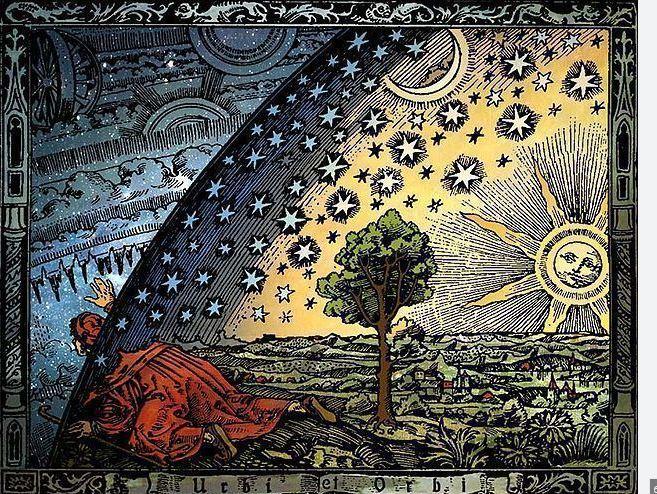Vertical Worldview

The term "senkrechtes Weltbild" is a German phrase that roughly translates to "vertical worldview" in English. This concept, though not commonly discussed in mainstream philosophical literature, is sometimes used in certain philosophical, esoteric, and metaphysical contexts to refer to a particular way of understanding the world. It contrasts with the more conventional horizontal worldview, which typically represents an understanding of life and the universe based on physical, material, and social dimensions. Here's an exploration of what a vertical worldview might imply:
1. Vertical Worldview in Esoteric and Spiritual Traditions:
In many esoteric and spiritual traditions, the vertical worldview represents a perspective that sees the world as a dynamic, layered system with a higher spiritual realm above and a material, physical realm below. This vertical axis is often imagined as a connection between:
-
The spiritual or divine realm (above),
-
The earthly, physical realm (in the middle),
-
The underworld or subconscious (below).
This metaphorical structure suggests that human beings are not just creatures of the earth, confined to the material world, but are instead spiritual beings with a connection to higher, transcendent realities. The vertical axis implies that we can ascend spiritually (through practices like meditation, prayer, or self-awareness) or descend into lower, more materialistic, or unconscious states.
2. Symbolism of the Vertical Axis:
-
Upward and Downward Movement: The vertical axis typically implies a kind of spiritual ascension (upward) toward enlightenment, divinity, or cosmic truth. It also suggests the possibility of spiritual descent or a journey toward inner darkness, ignorance, or the unconscious. In some mystical traditions, these ideas are symbolized by concepts like heaven and hell, light and darkness, or divine and earthly realms.
-
Union of Opposites: The vertical worldview can also be understood in terms of reconciling dualities—spirit and matter, consciousness and unconsciousness, the divine and the mundane. This idea aligns with many esoteric traditions that focus on the integration of opposites as a spiritual goal. For example, achieving enlightenment might involve balancing and harmonizing both the higher and lower aspects of the self.
3. Vertical Worldview in Philosophy and Mysticism:
Some philosophical and mystical systems use the vertical axis to depict the process of spiritual growth and self-realization. Here's how it might be explored in these contexts:
-
In Kabbalistic Mysticism: In Kabbalah, the Sefirot (the divine emanations) can be imagined as part of a vertical hierarchy. The higher Sefirot represent closer connections to the divine, while the lower ones are more connected to earthly existence. In this worldview, human beings are seen as being in the middle of this vertical axis, with the possibility of either rising toward higher spiritual realization or descending into materialism and forgetfulness of the divine.
-
In Christian Mysticism: In Christian mysticism, the concept of ascending to God or descending into hell often involves a vertical journey. This can be seen in imagery like Jacob’s Ladder, where angels ascend and descend, symbolizing the connection between heaven and earth and the potential for spiritual ascent or descent.
4. In the Context of Human Development:
In more psychological or philosophical terms, the vertical worldview can refer to an understanding of personal or human development that transcends the surface-level, material experiences (often seen in a horizontal worldview) to focus on deeper, inner experiences, the psyche, and the spiritual self. It might be contrasted with horizontal worldviews, which prioritize external, social, and material realities such as society, politics, or physical needs.
For instance:
-
Vertical growth may represent the development of inner qualities, self-awareness, moral virtue, and spiritual insight.
-
Horizontal growth, on the other hand, may focus on increasing external knowledge, skills, and social interactions.
The vertical dimension, then, can symbolize the growth of consciousness, where an individual ascends to a higher level of understanding or existence.
5. In a Broader Cultural or Theological Context:
In some religious or theological frameworks, the vertical worldview is seen as representing a sacred, ordered cosmos where human beings are encouraged to seek connection to divine truth and transcendence. Heaven is considered above, earth is in the middle, and hell or the lower worlds are beneath. This framework is often reflected in the cosmologies of many world religions, from Christianity to Hinduism, and is linked to moral or spiritual ascension.
In Summary:
A vertical worldview (or senkrechtes Weltbild) typically represents a spiritual or metaphysical understanding of the world that sees life as layered, with a higher realm (spiritual or divine) above, a middle realm (earthly existence) in the center, and a lower realm (often associated with the subconscious or the underworld) below. This perspective suggests that human existence is not just about material and social realities (which would be emphasized in a horizontal worldview), but is also deeply connected to higher, transcendent truths, moral growth, and spiritual ascent. The vertical axis can serve as a metaphor for spiritual growth, the reconciliation of opposites, and the connection between heaven and earth.
